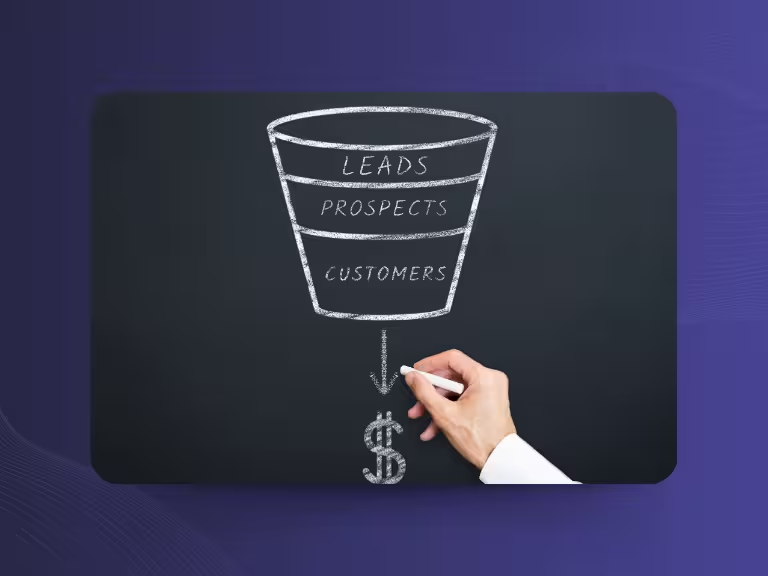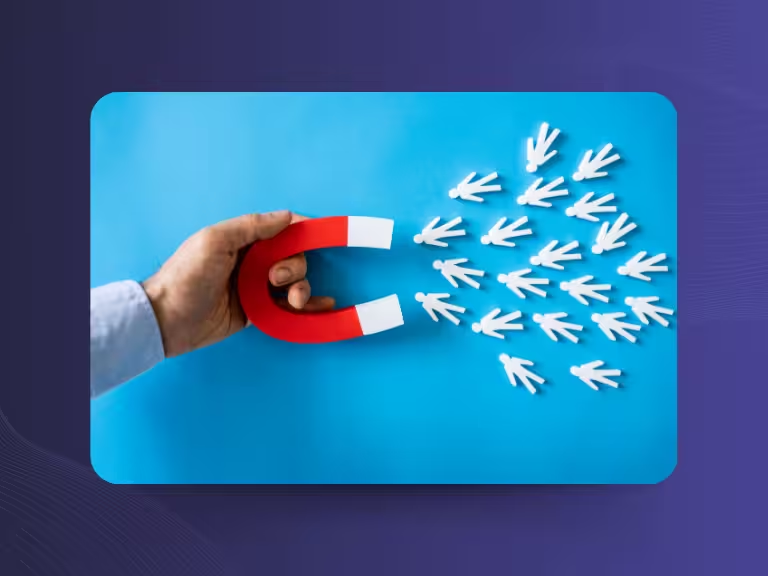Lead generation is the systematic process of identifying and acquiring potential prospects to convert them into paying customers over time. In today's digital business world, this process is more important than ever: According to current studies, 68% of companies rely heavily on digital lead generation tactics, while competition for attention continues to intensify.
This development is not coincidental. Digitalization has fundamentally changed buying behavior – customers now research independently online, compare offers, and make informed decisions before they even establish direct contact with a company. In this article, you'll learn everything you need to know about modern lead generation: from basic processes to proven strategies, professional success measurement, and the important aspects of data protection.
What Does Lead Generation Mean? Understanding Fundamentals and Processes
Definition and Objectives of Lead Generation
Lead generation refers to the strategic process of identifying and acquiring potential prospects who show genuine interest in a company's products or services. A lead is more than just a name in a database – it's a person or company that has voluntarily provided contact information and is fundamentally willing to learn more about your offering.
The crucial difference between a lead and a customer lies in their development stage: While a customer has already made a purchase decision, a lead is still in the information and evaluation phase. Leads are indispensable for businesses as they form the foundation for sustainable growth and enable a predictable sales pipeline.
The Lead Generation Process Overview
The lead generation process consists of three central phases: lead acquisition, lead qualification, and conversion. In the acquisition phase, potential prospects are made aware of the company through various marketing measures. Qualification then evaluates how likely a purchase decision is, while the conversion phase encompasses the actual sales closure.
Particularly important is the distinction between Marketing-Qualified Leads (MQL) and Sales-Qualified Leads (SQL). MQLs have shown basic interest, for example by downloading a whitepaper or participating in a webinar. SQLs, however, have already signaled concrete purchase interest and are ready for direct sales contact.
The nurturing process – the continuous cultivation of leads – is crucial for success. Studies show that companies with structured lead nurturing generate 50% more sales-ready leads at 33% lower costs.
.avif)
Effective Lead Generation Strategies and Techniques
Inbound Marketing as a Sustainable Lead Source
Inbound marketing has established itself as one of the most effective methods for sustainable lead generation. The approach is based on attracting potential customers through valuable content, rather than interrupting them with advertising.
Content marketing forms the heart of successful inbound strategies. High-quality blog articles, detailed whitepapers, informative videos, and interactive webinars attract qualified leads while simultaneously establishing trust and expertise. A particularly successful example is HubSpot, which generates over 100,000 leads monthly through consistent content creation.
SEO and social media significantly amplify organic reach. Through targeted search engine optimization, content is found precisely when potential customers are searching for solutions. Social media platforms like LinkedIn for B2B or Instagram for B2C expand reach and enable direct dialogue with the target audience.
Using Outbound Methods Strategically
Although inbound marketing dominates, outbound methods still have their place, especially as a complement to organic strategies. Professional email campaigns and strategic cold calling can, when used correctly, generate high-quality leads.
Paid advertising through Google Ads or social media ads enables quick targeting of specific audiences. The advantage lies in direct control over reach and target audience, although these methods require continuous investment and careful optimization.
The key lies in balance: While outbound methods can deliver quick results, inbound strategies offer better long-term cost-benefit ratios and higher lead quality.
Lead Nurturing as the Key to Conversion
Lead nurturing is the process of continuous relationship building with potential customers through personalized, relevant communication. Automated email marketing plays a central role here, as it enables systematic provision of appropriate content to leads.
Modern CRM systems like Salesforce or HubSpot are indispensable tools for effective lead nurturing. They document all interactions, automatically segment leads, and enable personalized communication at scale. Marketing automation can increase conversion rates by up to 30% by delivering the right message at the optimal time to the right person.
A practical example: A software company develops an email series for leads who have downloaded an eBook. The series includes case studies, product demos, and customer experiences – tailored to the individual position in the buying process.
Distinctions in B2B vs. B2C Lead Generation
The differences between B2B and B2C lead generation are fundamental and require adapted strategies. B2B leads typically go through longer decision processes, as multiple stakeholders are usually involved. Here, detailed, technical content like whitepapers and case studies is particularly valuable.
B2C leads, on the other hand, often make faster, more emotional purchase decisions. Visual content, social proof, and time-limited offers work particularly well here. The challenge lies in creating personal connection despite large reach.

Technology, Measurement, and Data Protection – Success Factors of Modern Lead Generation
Technological Tools for Efficient Lead Generation
Modern lead generation is hardly conceivable without the right technology. CRM systems form the backbone of any professional lead generation, as they centrally manage all customer data and optimize sales processes. Marketing automation extends this functionality with the ability to create and automatically execute individual customer journeys.
AI-powered tools are revolutionizing lead qualification. Chatbots can handle and qualify initial inquiries around the clock, while predictive analytics helps predict the purchase probability of leads. These technologies not only increase efficiency but also the accuracy of lead evaluation.
A particularly interesting approach is the integration of meeting assistants like Sally into the lead generation process. Sally can support teams in documenting sales conversations, extracting important insights, and seamlessly integrating into CRM systems. This ensures comprehensive documentation and prevents important lead information from being lost.
KPIs and Analysis – Measuring Lead Generation Success
Measuring success is crucial for continuous optimization of lead generation. Relevant metrics include the conversion rate, which shows what percentage of leads actually become customers, as well as the cost per lead (CPL), which evaluates the efficiency of various acquisition channels.
Particularly important is evaluating lead quality through the distinction between MQLs and SQLs. The Customer Lifetime Value (CLV) helps understand the long-term value of different lead sources and allocate marketing budget accordingly.
Tools like Google Analytics, HubSpot Analytics, or specialized BI solutions provide detailed insights into lead generation campaign performance. Data-driven decisions based on these analyses can significantly increase lead generation effectiveness.
Data Protection and Ethical Aspects
With the introduction of GDPR and other data protection laws, legally compliant collection and storage of lead data has become a critical success factor. Companies must ensure they obtain lawful consent and transparently inform about data usage.
However, data protection should not be understood as an obstacle, but as a competitive advantage. Companies that handle customer data responsibly build stronger trust and can achieve higher conversion rates in the long term. Transparency in data collection and processing is increasingly becoming an important differentiator.
Ethical lead generation also means only sending relevant and valuable content and respecting lead preferences. Spam-like practices not only damage reputation but can also have legal consequences.

Practical Examples, Best Practices, and Recommendations
Successful Case Studies and Lessons Learned
IBM achieved impressive results through implementing a comprehensive lead nurturing strategy. By segmenting their leads by industry and company size and developing specific content series, IBM was able to increase conversion rates by 25% while simultaneously shortening sales cycles by 30%.
HubSpot itself is a prime example of successful inbound lead generation. Through consistent content creation, SEO optimization, and marketing automation, the company has built a system that generates over 100,000 leads monthly. Particularly successful was the introduction of free tools that serve as lead magnets while providing genuine value.
These examples show that targeted content segmentation and systematic lead nurturing can increase conversion rates by up to 30%. The key lies in consistently aligning all measures to the specific needs and challenges of the target audience.
Concrete Tips for Implementation in Your Own Company
For successful lead generation, you should choose a balanced combination of inbound and outbound strategies. Start with a solid content foundation and complement it with targeted paid advertising in the channels where your target audience is present.
The effective use of automation and personalization is crucial. Use modern CRM systems to document all lead interactions and enable automated yet personal communication. Tools like Sally can help ensure no important information from conversations is lost and seamlessly integrate it into your systems.
Data protection should be understood as a competitive advantage. Invest in transparent processes and legally compliant data collection – this builds trust and can lead to higher conversion rates in the long term.
Continuous optimization through analysis and testing is indispensable. Regularly test different approaches, measure results, and optimize your strategy based on the insights gained.
Outlook: The Future of Lead Generation
The future of lead generation will be significantly shaped by artificial intelligence and predictive analytics. These technologies enable not only managing who is already a lead, but predicting when a lead is ready to buy and which measures increase conversion probability.
As Brian Halligan, Co-Founder of HubSpot, aptly stated: "Lead generation is not just a marketing process, but a company-wide commitment – from initial contact to customer service." This holistic view is becoming increasingly important.
Companies that want to position themselves for the future should invest in modern technologies, make data-driven decisions, and use ethical standards and data protection as competitive advantages. The integration of various tools and platforms will play a central role.
Conclusion
Lead generation is now essential for sustainable growth in the digital world. Successful companies understand lead generation as a holistic process that intelligently combines modern strategies, innovative technology, data-based analysis, and ethical principles.
The key insights for your practice: Combine inbound and outbound strategies, use modern CRM systems and marketing automation, and see data protection as an opportunity, not an obstacle. Particularly important is continuous optimization based on measurable KPIs and the willingness to integrate new technologies like AI-powered tools.
The future belongs to companies that understand lead generation as a company-wide process while bringing technology, ethics, and customer orientation into harmony. With the right strategies and tools, you can not only generate more leads but also sustainably increase their quality and conversion rates.

Test Meeting Transcription now!
We'll help you set everything up - just contact us via the form.
Test NowOr: Arrange a Demo Appointment




